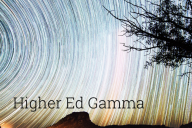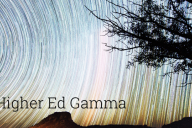You have /5 articles left.
Sign up for a free account or log in.
It is easy to think that the history of higher education is irrelevant to the challenges that today’s colleges and universities face. After all, as recently as 1870, just 50,000 men and women attended college – just 1.7 percent of the college aged population. Today, in stark contrast, 20.5 million (57 percent female and 17 percent African American, Hispanic, Asian, or Native American) attend a postsecondary institution. That’s over 40 percent of 18 to 24 year olds.
In fact, the history of higher education is filled with important lessons for those interested in envisioning the future of postsecondary education. Let’s look at 11 lessons.
Lesson 1. Debates over the mission and meaning of higher education are longstanding.
Among the first and most influential efforts to define the purpose of American higher education was the Yale Report of 1828. Often misread as a defense of a narrow, moribund classical curriculum, the report in fact offered an alternative to a theologically- or classically grounded curricula and vocational or pre-professional training in favor of an education designed to nurture the architecture of the mind and to promote self-formation.
At various points in time, other definitions of the purpose of higher education prevailed: To form character, refine the sensibilities, and immerse students in the best that has been thought and said; to think critically and reflectively about values, politics, and society; and to provide an opportunity to grow and mature personally and intellectually. As higher education’s student body has expanded and grown increasingly diverse, any consensus about college’s primary purpose has eroded.
Today’s dominant view, enshrined in mission statements and presidential addresses, presents an uneasy mixture of goals: On the one hand, to serve the needs of workforce development and economic and social mobility; on the other, to nurture democratic citizenship, global perspectives, critical thinking, and community service. Yet the reality at most institutions is a fragmented curriculum that pays little attention either to helping students identify a career and a realistic path forward or to their aesthetic, ethical, intellectual, or social development.
Lesson 2. Transformation is as much a part of the history of higher education as continuity.
The half century stretching from 1865 to 1915 witnessed the emergence (or invention) of many characteristics that still define traditional colleges and universities: The popularization of letter grades, departments, electives, majors, and the credit hour. The faculty role, too, shifted profoundly over time. Tenure, academic freedom, and shared governance are largely products of the first half of the twentieth century. An emphasis on faculty research arose after World War II.
The academy is often viewed as the institution most resistant to change, but we are in the midst of another era of dramatic transformation. Pedagogy, delivery modes, instructional staffing, and assessments are all being rethought – driven in part by advances in the learning sciences, cost pressures, and a new generation of students with distinct interests and needs. I suspect that the faculty role will shift further in the years ahead to meet this new reality, with an increasing emphasis on the faculty member as learning architect – a designer of learning experiences, a mentor, and overseer of independent research, internships, study abroad, and other forms of experiential learning.
Lesson 3. The student body has never been homogeneous -- or passive.
American higher education was never as exclusively elitist as is sometimes assumed. Even in the colonial era, the student body included sons of farmers, like John Adams, and other non-elites, like Alexander Hamilton. As the student body gradually expanded, distinct subgroups emerged. By the early twentieth century, these subcultures included frat boys, sorority girls, strivers, bohemians, rebels, radicals, and various outsiders. Today, the fastest growing segments of the student population consists of non-traditional students: low-income students, full-time workers, working adults, parents, and those seeking continuing and professional education. As a result, higher education needs to adjust to better meet needs that are very different from their predecessors.
Shifts in the composition of the student body are one theme in the history of higher education. Another is the recurrence of student unrest. There haven’t been many Silent Generations among college studnets.
Since the 1760s, campus unrest has been a fact of college life. Indeed, upheaval was probably greatest not in the 1960s, but in the early 19th century, before colleges began concerted efforts to defuse tensions by reducing paternalistic discipline and expanding the number of elective courses. Especially important in reducing unrest was freeing students to organize extracurricular activities. Fraternities and sororities, competitive athletics, literary and debating societies and other groups were originally established and run by students themselves. But gradually these came under the institutions’ purview and tutelage. Whether this is the best way to promote student emotional, social, and intellectual development is certainly debatable.
Lesson 4. Higher education, in the past, played an important role in social mobility and economic growth.
Whether colleges and universities are still playing that role remains an ongoing source of controversy. No longer does the United States lead the world in college participation and in university-based research. Gains in college completion rates and affordability have been modest. Access has expanded, but gaps in attendance at selective institutions by class, ethnicity, and race, persist. At the same time, spending on instruction and academic support and student services is in inverse proportion to student needs.
College has become this society’s chief mechanism for individual advancement, upward mobility, economic growth, and social equity. But it is not currently fulfilling this mission adequately.
How, we might ask, can we bring many more young adults to a bright future? Clearly, selective institutions need to enroll larger numbers of students from low-income and underrepresented groups.
In addition, higher education also needs to better serve the new majority of non-traditional students: transfer students, part-time students, adult learners, commuter and part-time students.
The sad fact is that most institutions were not designed with non-traditional students in mind. Many institutions still offer an education that lacks the flexibility or support structures that many non-traditional students need. Meanwhile, the fastest growing market segment – continuing and professional education – remains underserved. Part of the answer might lie in greater access to alternate credentials – badges, certificates, professional certifications, among others – which do not require four years to vest, but which could stack into degrees.
Lesson 5. Forms of pedagogy and assessment have changed to meet the shifting needs of the time.
How we teach and assess reflect the kinds of graduates we hope to produce. Do we want to bring as many students as possible to mastery – or do we want to separate the wheat from the chaff? Do we want students who can collaborate, manage products, and solve problems -- or do we want students to be able to recall facts?
During the nineteenth century, an older form of pedagogy, emphasizing recitation and memorization (and corporal punishment and shaming) gave way to an approach centered squarely on lectures. Around the same time, the faculty role evolved, as the faculty role became increasingly specialized, professionalized, and departmentalized.
A particular mindset also overtook the academy -- a set of attitudes well-suited to the Industrial era. It involved a “mass production,” “one-size-fits-all” paradigm, which assumed that all students should acquire the same information at the same pace, and a “transmission” model of instruction, in which a content expert delivered a body of information to passive students. This was accompanied by an increasing reliance on standardized tests and a sink-or-swim mentality in which the role of grading was to rank students.
It’s not surprising that in the middle of the last century, middle managers were prepared at mid-tier institutions by taking multiple choice tests. Higher education was preparing students for their class position and future roles: Filling out forms.
Already, it seems that the Information Age is bringing a fresh approach to pedagogy that is more personalized, immersive, interactive, self-paced, adaptive, and experiential, stressing collaboration and active learning – and more inquiry-driven and learner-focused.
Lesson 6. American higher education has, over its history, exerted a disproportionate influence on society.
This was true even in the mid-eighteenth century, when there were only nine colleges. Princeton, in particular, played a pivotal role in defining and disseminating Republican ideals, with their emphasis on civic virtue and fear of entrenched power, which helped fuel revolutionary sentiment. In the twentieth century, colleges and universities have also driven cultural change, perhaps most during the 1960s, when the institutions were at the forefront of the free speech and Civil Rights movements, the sexual revolution, and the women’s liberation movement.
What happens on college campuses rarely stays there, and the current shifts in attitudes toward gender and sexual identity and politics are unlikely to remain within campus walls.
Lesson 7. Many current debates have a long, contentious history.
Controversies surrounding grade inflation, town-gown antagonisms, fraternities, general education, and vocational versus liberal education are nothing new. A knowledge of history can help us understand whether present-day concerns are exaggerated or accurate, and what is novel about contemporary anxieties and apprehensions.
Lesson 8. The history of new educational technologies is largely a history of unrealized promise.
The history of higher education is littered with flawed techno-fads: Overhead projectors, slide projectors, reading accelerators, B.F. Skinner’s “teaching machines,” film strips, educational television, video tapes, multimedia CDs, Second Life, PowerPoint slides, chat rooms, and clickers. All promised to revolutionize learning. None succeeded.
Given this history, one must ask: Will today’s personalized, adaptive software, virtual and augmented reality, and educational games be any different?
These innovations certainly won’t if they replace human interaction with programmed learning that consists of little more than skills and drills or edu-tainment, and provides little in the way of substantive feedback. But technology can, of course, be used differently: To promote inquiry, enhance collaboration, offer case-based or challenge-based learning experiences, and, above all, to give students opportunities to create – digital stories, audio tours, annotated texts, virtual encyclopedias, and a host of other projects.
Lesson 9. Claims that higher education is in crisis are nothing new.
Virtually every decade over the past century has produced books with such titles as Higher Education in Crisis (1995), The Education Crisis (1988), Campus Unrest (1970), The Big Squeeze: Crisis on the Campus (1946), and Crisis on the Campus (1900). The concerns have certainly shifted, but the belief that higher education is faced with impending calamity continues.
The key question, as the economist Irwin Feller has suggested, is whether this time is different: Whether a confluence of factors – a long-term decline in per student state funding, a rise in net tuition, stagnating federal funding of academic research, and the increasing costs of information technology, support services, shifts in student behavior, and compliance with government mandates -- have combined to fundamentally threaten higher education’s business models. There is reason to think that yes, this time is different: That tuition and institutional expenses cannot continue to rise at the rate they have; that levels of student and familial debt have reached their limit; and that alternate providers and alternate credentials pose an unprecedented threat to higher education’s monopoly over educational credentialing.
Higher education has, of course, experienced many challenges, and has survived with relatively few changes in its organizational structure. Whether that will continue to be the case, time will tell.
Lessons 10. The diverse character of higher education is postsecondary education’s greatest strength and weakness.
As David F. Labaree has recently argued, American higher education’s defining attributes are its diversity, its decentralized character, and its relative freedom from central coordination. From the early nineteenth century onward, the higher education ecosystem included a wide range of institutions – ranging from the academies, normal schools, engineering institutes, and trade schools of the nineteenth century to today’s research universities, regional comprehensives, liberal arts colleges, historically-black and religious colleges and universities, and community colleges – each with its own distinct identity, mission, student profiles, donors, and business strategies.
Yet if diversity and lack of coordination created a highly competitive higher education marketplace that allowed the system to serve diverse student bodies and survive good times and bad, there is reason to worry that college rankings, the pursuit of prestige, and institutional emulation are now undermining the ability of many colleges and universities to adapt to a volatile environment where students are acquiring credits from multiple institutions, where alternate providers are offering new kinds of credentials, and where entrepreneurial universities are taking the lead in seizing new markets.
It has seemingly become more difficult for many incumbent institutions to break free of the boxes that have defined higher education for the past century, to radically rethink curricular designs or class schedules or the academic experience as a whole. This is not only out of a fear of a loss of prestige but because of the drag of inertia, entrenched interests, and legacy processes and technologies.
Lesson 11. Narratives of progress or decline obscure as much as they reveal.
Nostalgia for a lost golden age is a fool’s game. So, too, is a faith in inevitable progress. Neither Whiggish histories of higher education, stressing progress, nor declensionist histories, emphasizing decline, accurately depict the history of American colleges and universities.
To be sure, there are certain broad themes in the history of higher education: These include the democratization of access, the professionalization of the faculty, curricular expansion, and an increase in academic specialization and the importance of faculty research. But there have also been countertrends, including an increasing stratification of higher education in terms of mission and resources and a deepening divide in the experiences of affluent and lower income students. Reforms and innovations – like Robert Maynard Hutchins’s experiments in undergraduate education at the University of Chicago, or those a generation later at the University of California Santa Cruz -- have come and gone.
My take-aways from this history lesson are two in number. The first is that for far too long, American higher education has been institution-centered rather than learner-centric. It’s not that institutions don’t provide students with a host of services and activities. It is certainly the case that many colleges and universities regard students as customers that need to be aggressively recruited and treated with kid gloves. But a customer focus isn’t the same as a learner focus, which involves commitments to bringing all students to mastery, designing learning experiences that are engaging and immersive, introducing pedagogies and modes of delivery that meet the needs of all students, and providing frequent feedback and interaction, wrap around support and mentoring.
My second take-away is that full-time tenured faculty and administrators have tended to emphasize their own convenience at the expense of students’ educational needs. Too often, curricula, schedules, pedagogies, assessments, and workload policies reflect the interests of departments rather than what we know about teaching and learning, students’ developmental needs, or the challenges faced by today’s growing number of non-traditional students.
Those take-aways underscore the need for continued innovation, experimentation, and a focus on student development across all dimensions.







